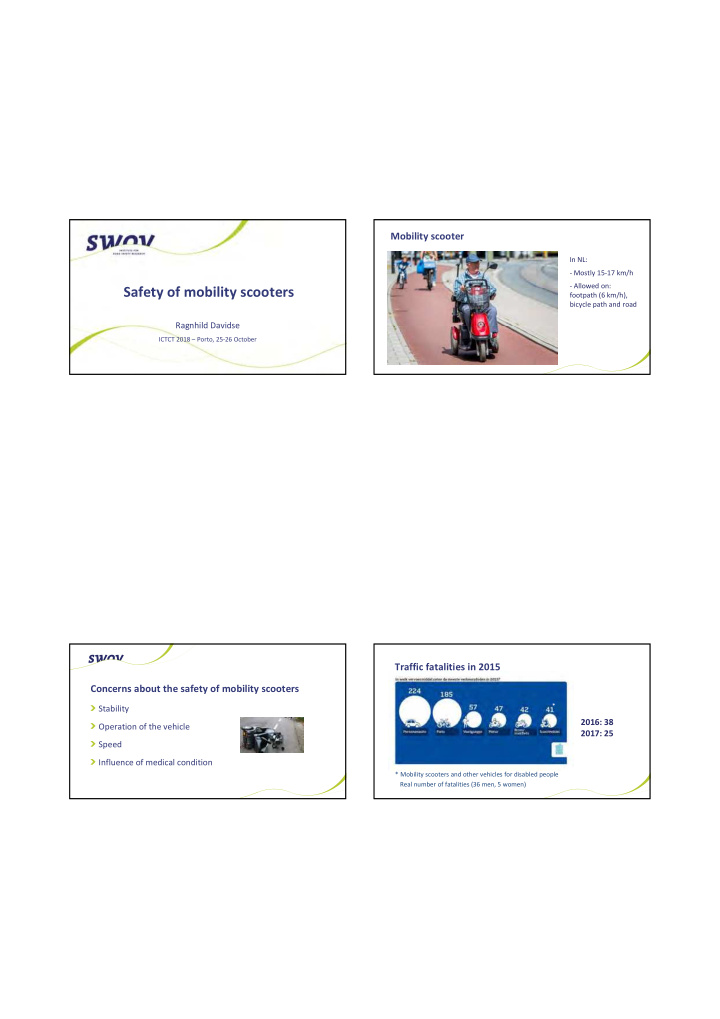



Mobility scooter In NL: - Mostly 15-17 km/h - Allowed on: Safety of mobility scooters footpath (6 km/h), bicycle path and road Ragnhild Davidse ICTCT 2018 – Porto, 25-26 October Traffic fatalities in 2015 Concerns about the safety of mobility scooters * Stability 2016: 38 Operation of the vehicle 2017: 25 Speed Influence of medical condition * Mobility scooters and other vehicles for disabled people Real number of fatalities (36 men, 5 women)
Insight in accidents involving mobility scooters In-depth study of traffic accidents (2015-2017) Survey among riders of mobility scooters “Scootmobiel experience” Literature review Interviews with manufacturers and suppliers Meeting with stakeholders Insight in accidents involving mobility scooters SWOV in-depth research In-depth study of traffic accidents (2015-2017) Focused on one type of accidents Survey among riders of mobility scooters Detailed data collection “Scootmobiel experience” Soon after the accident Literature review Multidisciplinary team Interviews with manufacturers and suppliers Analysis of each accident (30 – 40) Meeting with stakeholders Scenarios of similar accidents
Total set of investigated accidents Aim and focus 35 accidents, of which 7 ended in water Mobility scooter riders: How do these accidents develop? 14 men, 21 women 50% above 75 yrs Discover the interplay of factors (accident and injury) Mostly riding on a 3-wheel mobility scooter Most of them quite experienced Find leads for measures to prevent similar crashes in future Injury severity: 9 fatalities 10 hospitalized Total set of investigated accidents Four accident scenario’s Type of accidents: Single vehicle, although other road user often played a role Rider wants to brake but accelerates Obstacle Collision with another vehicle, mostly motorized traffic Rider looses his balance after hitting an obstacle Rider swerves to avoid a collision and falls General circumstances: Daylight Rider collides with motorised traffic while crossing the street Inside urban areas (50% on bicycle facility, rest on pavement or road)
Operational mistake leads to a fall Accelerates when he wants to break (reflex) Many accidents end in the water Mostly younger riders (< 75 years) Injury severity is less severe than average (MAIS 1) Operational mistake leads to a fall Promising measures: Accident factors : Operation of the accelerator and brake is counterintuitive Accelerator and brake should be seperated. Minimum Recent change of mobility scooter or unexperienced rider Grasps the steering wheel to retain balace requirement of an emergency button to stop the vehicle. Injury reduction: Rescued by people who passed by
Tipping over after hitting an obstacle The kerb is hit when the rider takes a turn Loss of balance, vehicle tips over and rider falls Average rider (age and gender) Average injury severity (MAIS 1-2) Tipping over after hitting an obstacle Promising measures: Accident factors : Lateral position close to the edge of the bicycle path Improve compliance with design guidelines (minimum width of and curve radius on bicycle paths) Bicycle path too narrow (according to guidelines) Curve radius too narrow Improve the stability of mobility scooters (4 wheels, larger Low obstacle next to the bicycle path wheels with suspension) Medical condition of the rider Mobility scooter is instable on an uneven surface
Swerve leads to a fall Sudden steering manoeuvre to avoid a collision Mostly while crossing the road Swerving is the only option left (late observation) Mobility scooter tips over Mostly younger riders (< 75 years) Average injury severity (MAIS 1-2) Swerve leads to a fall Promising measures: Accident factors: Other road user did not yield or thought the MSR was waiting Traffic lights should prevent conflicts, and be adjusted to the speed and reaction time of older road users and scooter riders Traffic lights do not rule out conflicts Mobility scooters should have a brake that can be operated by Rider has little time and space to act the rider Mobility scooter is an instable vehicle
Collision with motorised traffic while crossing Type A: scooter rider crosses without right-of-way Type B: turning vehicle does not give right-of-way Not noticed or wrong expectations Older riders (> 75 yrs) Male riders More severe injuries (many fatalities) Collision with motorised traffic while crossing Promising measures: Accident factors: Crossed without right-of-way (running red light) Traffic lights should prevent conflicts, and be adjusted to the speed and reaction time of older road users and scooter riders Other road user did not notice scooter rider in time Obstructed view or attention focused on other road user Improvement of the conspicuity of scooter riders and crossings Injury factor: Trapped beneath other vehicle or between two vehicles
Other recommendations Dilemma’s Remove obstacles from the bicycle path Fit mobility scooters with airbags Safety versus Retaining independent mobility Change vehicle regulation (more requirements) Vehicle on public road versus Medical device Improve registration of mobility scooters and accidents Costs of providing scooters versus Savings in medical care involving mobility scooters No data on the number of vehicles and accidents Please share information on the Thank regulation and use of mobility scooters in your country you! davidse@swov.nl swov.nl
Recommend
More recommend